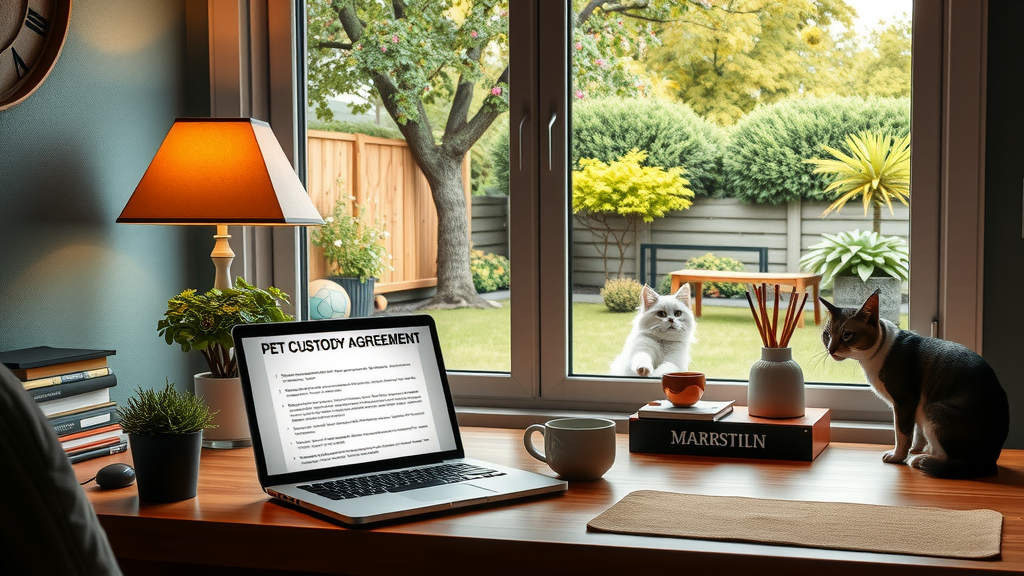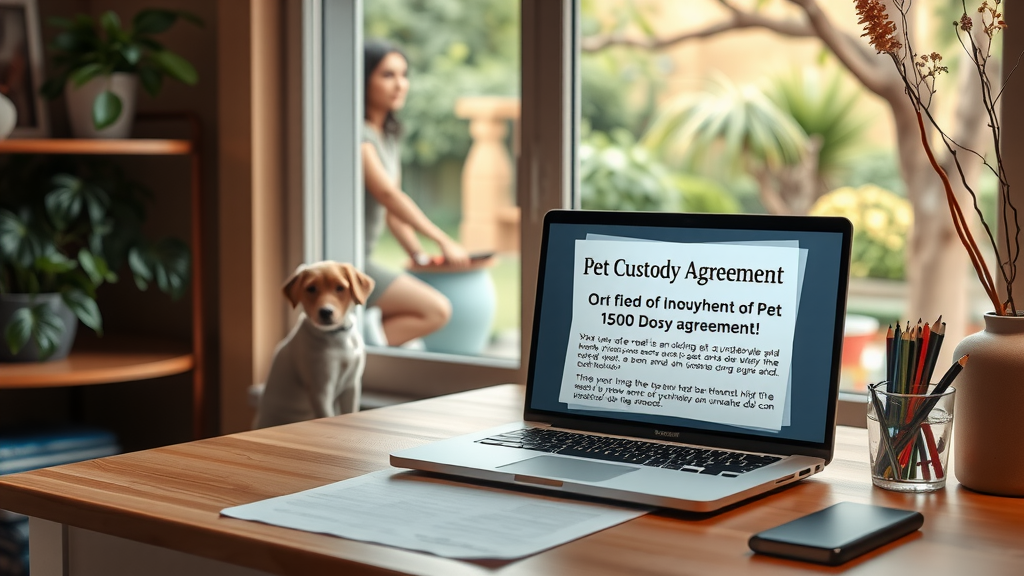
The increasing emotional attachment between humans and animals highlights the need for comprehensive pet custody agreements during separations or divorces. These agreements prevent conflicts by establishing clear terms.
Animal visitation rights are essential to maintaining harmony, specifying holiday arrangements and travel adjustments.
Clearly defined shared animal responsibility is necessary, covering feeding, grooming, and veterinarian costs to ensure equitable financial responsibilities.
A detailed pet care obligations clause, including an emergency care protocol, helps in organizing pet essentials and setting up a care fund. Thoughtful pet sharing contracts offer a structured approach to shared pet ownership.
Pet Guardianship Plan Essentials
A well-defined pet guardianship plan offers more than temporary custody by ensuring long-term pet living arrangements.
Establishing roles through animal care guidelines for daily routines distinguishes it from short-term agreements. A pet coownership plan can incorporate financial aspects, detailing relocation rules and welfare provisions.
Legal consultations are advisable to guarantee the legal ownership and clarity, avoiding misunderstandings.
Care Coordination and Responsibilities
A gradual transition helps pets adjust to new guardians, facilitating emotional support and minimizing stress.
Regular updates and transparent communication standards between guardians reinforce commitment to animal welfare.
Structured care coordination ensures all duties are met, reflecting the dedication of a comprehensive pet guardianship plan.
Mediation process and clear communication can resolve disputes, ensuring pet welfare and fostering an amicable arrangement.
Joint decisions regarding pet care amendments and legal implications emphasize the importance of a robust custody strategy. Legal documents serve as a rights document, safeguarding the interests of all parties involved in shared parenting.

Animal Care Guidelines Overview
Pet guardianship plans are essential for ensuring the overall wellness of animals. Animal care guidelines provide a structured approach to maintaining pet health guidelines.
Implementing preventive measures, previously explored, results in enhanced well-being for pets.
Tailoring care to specific animal types can be particularly beneficial.
For instance, guinea pigs require regular vitamin C supplements because they lack the ability to synthesize this essential vitamin. Adopting such measures not only prevents health issues but also strengthens the bond between guardians and their pets.
Reliable resources are crucial for effective pet care.
The American Veterinary Medical Association offers comprehensive insights into best practices. By utilizing these resources, pet guardians can ensure alignment with the latest animal care guidelines and expert recommendations.
Emphasizing welfare prioritization goals helps in achieving optimal health outcomes for pets.
What Is A Pet Custody Agreement
Pet sharing contracts play a significant role in managing pet coownership arrangements.
A pet custody agreement is a formal document outlining the shared animal responsibility among parties.
This legal arrangement details the pet living arrangements and financial responsibilities, including veterinarian costs. Clarity in these agreements helps to avoid disputes related to care obligations.
For example, such contracts may include the following clause:.
Both parties agree to share veterinarian costs and consult each other on all non-emergency health decisions.
Such coparenting strategies facilitate effective care coordination and establish a foundation for cooperative animal care. These structures contribute to the smooth execution of care obligations and shared parenting, ensuring the welfare of pets.
Animal Care and Pet Custody
- Pet guardianship plans are essential for ensuring animal wellness.
- Guinea pigs need regular vitamin C supplements due to their inability to synthesize the vitamin.
- The American Veterinary Medical Association offers comprehensive insights into best practices for pet care.
- Pet custody agreements outline shared responsibilities and prevent disputes in coownership arrangements.
Exploring Pet Coownership Benefits
Pet coownership arrangements present a range of benefits that can be unexpected. One unique advantage involves the formation of support networks among co-owners, fostering a sense of community and shared animal responsibility.
This collaboration leads to social ties and shared resources, such as when co-owners of a dog created a friendship circle for pooled resources.
Additionally, pet guardianship plans and pet sharing contracts streamline communication, ensuring consistent adherence to animal care guidelines.
Here are some benefits:.
- Financial responsibilities, including veterinarian costs, are shared, reducing individual burdens.
- Co-owners can exchange insights into pet care obligations, improving shared knowledge.
An example of coownership advantage includes a group of dog co-owners who established an effective pet access plan, forming emotional support bonds and introducing companions for the pet.
Crafting A Pet Visitation Schedule
Pet guardianship plans often hinge on well-crafted pet visitation schedules to manage access effectively. Animal visitation rights ensure that time with pets is equitably divided, promoting a balanced environment. Integrating a pet living arrangement schedule within a pet access plan can optimize shared parenting experiences. A practical tip is to use calendar apps to facilitate communication standards and maintain flexible access. This system also allows for scheduling updates in response to any emergency care protocol.
- Ensure regular schedule reviews to reflect any care amendments or changes in pet living arrangements.
- Adjust visitation terms to align with welfare provisions and owners’ evolving needs.
Establishing clear relocation rules and transport logistics strategies further harmonizes arrangements while maintaining pet safety considerations.
Pet Coownership and Visitation
- Shared ownership reduces individual financial burdens by splitting veterinarian and care costs.
- Pet coownership fosters community connections, enhancing social support networks.
- Visitation schedules ensure equitable pet access, promoting balanced care environments.
- Using calendar apps for scheduling aids in maintaining consistent communication and flexibility.
Shared Pet Care Responsibilities
Pet guardianship plan implementation often involves managing shared pet care responsibilities under a structured pet custody framework. Establishing defined roles ensures the pet’s well-being and reduces potential conflicts.
Animal care guidelines suggest an effective strategy to rotate weekly duties, such as feeding and managing veterinarian appointments, which allows each owner to participate actively.
Communication standards highlight the importance of regular updates on pet activities and health status.
To enhance cooperation, schedule regular check-ins to discuss progress and any needed adjustments. Utilizing a shared calendar can further streamline responsibility coordination.
This structured approach fosters successful pet coownership and enhances the overall pet care experience.
Regularly engaging in these practices will not only enhance the mutual understanding between the co-owners but also significantly improve the overall pet sharing contract experience.
Understanding Pet Care Obligations
Pet access plan considerations must recognize the shared nature of care obligations arising from joint pet custody arrangements. Contrary to common beliefs, legal responsibilities are balanced between owners and not assigned to a single individual.
This misconception can lead to misunderstandings and affect agreements relating to animal visitation rights.
Pet living arrangements should be planned carefully.
By referring to animal care guidelines, owners can ensure all obligations are evenly distributed. Professional advice enhances compliance, ensuring all legal aspects of shared parenting are addressed.
Regularly reviewing and updating agreements can accommodate changes in circumstances, supported by a structured mediation process. Unraveling these complexities not only promotes the pet’s welfare but also strengthens the co-ownership bond.
Addressing Common Misconceptions
Shared animal responsibility often involves clarifying legal implications associated with joint custody.
Employing detailed animal care guidelines helps align expectations between parties, preventing potential disputes.
Enhancing Compliance
Financial responsibilities are better managed through consistent communication and regular reviews.
Using a communication standards framework ensures all parties understand their respective duties and obligations.
Pet Care Responsibilities
- Shared pet care responsibilities involve rotating weekly duties like feeding and vet appointments.
- Regular updates on pet activities and health are crucial for effective communication.
- Using a shared calendar can streamline responsibility coordination.
- Legal responsibilities in joint pet custody are balanced between owners.
Defining Pet Visitation Rights
Pet guardianship plans are pivotal in shaping animal visitation rights, focusing on the well-being of the pet involved. These agreements often include structured visitation terms that provide consistency, which is beneficial for the emotional stability of animals.
Studies suggest that regular visitation aligns with shared parenting goals, as consistent interactions contribute significantly to emotional support and reduce anxiety in pets.
Successful Visitation Setups
One effective example of a successful pet coownership strategy might involve a rotating weekend schedule.
This approach ensures that both parties have equal access to the pet, fostering a stronger care partnership.
Utilizing communication standards aids in coordinating schedules efficiently, allowing each guardian to adjust seamlessly. Such setups enhance the pet’s comfort while minimizing stress during transitions.
Providing pets with a predictable routine through visitation terms ensures their emotional well-being while strengthening the amicable arrangement between guardians.
Establishing Pet Living Arrangements
Pet living arrangements should prioritize animal care guidelines by creating environments that cater to a pet’s comfort and routine.
Connected to past discussions on structured living spaces, developing familiar surroundings reduces anxiety. A key consideration involves maintaining consistency in the cohabitation rules of the pet’s environment, ensuring safety and accessibility.
Transitioning Between Homes
Shared animal responsibility when transitioning between homes requires careful planning.
Ensuring transport logistics and a checklist of essentials like familiar toys can help maintain continuity.
These elements of the introducing companions strategy promote a smooth adjustment, keeping disturbances to a minimum and fostering a sense of security.
Utilizing a comprehensive pet sharing contract helps manage shared animal responsibility, ensuring welfare maintenance and emotional stability for the pet involved.
Pet Visitation and Living Arrangements
- Pet guardianship plans help establish structured visitation terms, promoting emotional stability in pets.
- Rotating weekend schedules in pet coownership ensure equal access and strengthen care partnerships.
- Predictable routines through visitation terms enhance pets’ emotional well-being and strengthen guardian arrangements.
- Consistent living arrangements and cohabitation rules reduce anxiety and ensure safety for pets.
How To Write A Cease And Desist Letter Independently
How To Write A Simple Rental Agreement Without A Lawyer